Access to free period products: baseline survey results
Report to present the baseline survey results on experiences and views towards access to free period products in Scotland. Data was collected prior to the Period Products (Free Provision) (Scotland) Act 2021 coming into force on 15 August 2022.
Experiences of accessing free period products
In order to understand the policy impact of free period products, it is crucial to understand the experiences of those accessing free period products, including how and where they obtain products, any challenges they have in doing so and the effect, if any, that access to free products has on their standard of living. Therefore, the survey asked questions on: accessibility, availability, and barriers to obtaining products; and the impacts on wellbeing and standard of living.
Access and availability to free period products
When respondents were asked if they had accessed free period products in Scotland so far (prior to the introduction of the Act), one in four reported 'yes, once for myself' (26%). Just over half had not accessed free period products (54%) (Figure 10).
QC1. Have you accessed free period products in Scotland so far?
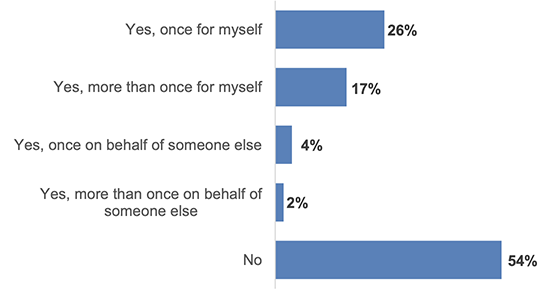
Base: All respondents (adult and children) (1400)
By sub-groups there were some statistically significant differences in accessing free period products in Scotland.
Given the early access in educational settings, young people were more likely than adults to have accessed free period products once for their self (69% compared to 22%). However, adults were more likely than young people to have accessed free period products more than once for their self (18% compared to 6%).
Further, 22% of respondents in households with an income under £20,000 reported accessing free period products more than once for their self. This reported figure was higher than those living in higher income households (17% in households with an income of between £20,000 and £40,000 and 15% for those living in households with an income over £40,000).
For those who had accessed free period products, 72% had done so due to 'a period starting unexpectedly/ forgetting to bring a product from home / not bringing enough products'. 21% had done so due to an 'ongoing need due to affordability. For young people, 23% accessed free period products because they had easy access to them at school (Figure 11).
QC1B. What was the main reason why you got free period products?
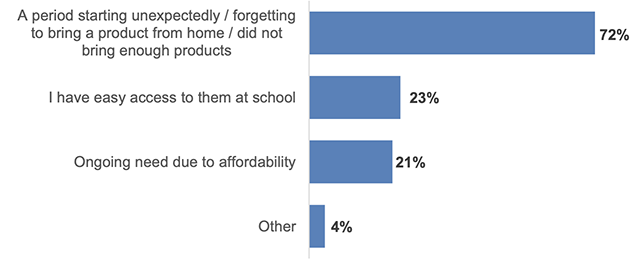
Base: All who had accessed free period products (643)
Notes: The reason 'Ongoing need due to affordability' differed in wording across the adult and young person questionnaire. Adult: 'Challenges with cost of living'. Young person: 'To save money / because I cannot afford products'. The reason 'I have easy access to them at school' was only asked to young people (aged 12-15 years).
Looking closely at the data by household income, there were some differences. Figure 12 highlights how as household income increases, the likelihood of needing to access free period products due to the challenges with cost of living tends to decrease.
QC1B. What was the main reason why you got free period products?
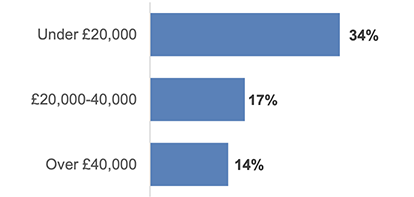
Base: All adults 16+ who had accessed free period products (524)
For those who had accessed free period products, half had obtained products from a school, college or university (49%). This is unsurprising given the early free provision in educational settings. Work and health centres were other commonly reported settings for obtaining free period products (23% and 20%, respectively). Respondents were less likely to have obtained free products from 'another council building' or have them 'sent to their home' (3% and 8%, respectively).
By respondent type, young people were more likely than adults to report obtaining their free period products from a wider range of settings with higher proportions reported across a range of settings (Table 7). For example, half of young people had obtained products from a health centre (51%), while a third had obtained products from a public library (compared to 15% and 9%, respectively, for adults).
| Percentage of respondents | 12-15 year old respondents | 16+ respondents | |
|---|---|---|---|
| At school / college university | 49% | 91% | 42% |
| At work | 23% | 0% | 26% |
| At a health centre | 20% | 51% | 15% |
| At a public library | 12% | 32% | 9% |
| At a leisure centre | 10% | 30% | 7% |
| Sent to my home | 8% | 4% | 8% |
| At another council building | 3% | 5% | 3% |
| Other | 4% | 0% | 4% |
| Don't know | 1% | 0% | 1% |
Base: All who had accessed free period products (643); young people (12-15 years) who had accessed free period products (86); (adults 16+) who had accessed free period products (557)
Question: C2. Where did you get free period products from?
Understanding experiences of obtaining free period products is important as the Act places a duty on period products to be obtained reasonably easily and in a way that that reflects the dignity of persons obtaining them. Therefore, respondents who had accessed free period products were asked to consider two statements: 'The building where I got the free products from was convenient and easy to access'; and, 'Once I was at the building, the free period products were at a convenient location and reasonably easy to obtain' (Figure 13).
Agreement with both these statements was high, with 83% agreeing the building was convenient and easy to access and 85% agreeing that once inside the building, free period products were conveniently located and easily obtained.
QC3.1-C3.2. How much do you agree or disagree with the following statements?
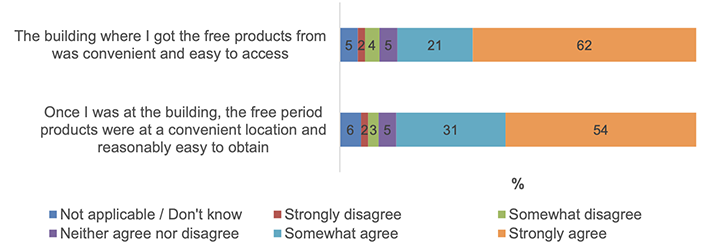
Base: All who had accessed free period products (643)
Notes: Figure 13 displays the summary disagreement and agreement levels of respondents. Tables C3.1-C3.2 in the data provide a breakdown of the response options on a five point agree/disagree scale. Where stacked bars do not total 100% it is due to percentages being rounded to the nearest whole.
Generally, young people were more likely than adults to agree with these two statements. 96% of young people agreed the building where they obtained free period products was convenient and easy to access (compared to 81% of adults). 95% of young people agreed once inside the building here they obtained free period products, the products were conveniently located and easy to obtain (compared to 83% of adults).
The Act further sets out that when obtaining free period products those people who need to use them should be offered a reasonable choice of period products. Therefore, the survey asked respondents if they were able to obtain their preferred period product when accessing free provision in order to obtain a baseline understanding of provision. Nine in ten respondents were able to obtain their preferred period product (88%). A further 10% were unable to access their preferred period product and 2% could not recall. Access to preferred free period products was relatively consistent across sub-categories.
For those who had accessed free period products but had been unable to obtain their preferred product, 86% would have preferred to access single use products, such as single use sanitary towels or liners (54%) or tampons (41%). 25% would have preferred to have access to reusable products, such as reusable pads (18%), period underwear (17%) or menstrual cups (10%) (Table 8).
| Percentage of respondents | |
|---|---|
| Single use sanitary towels or liners | 54% |
| Tampons | 41% |
| Reusable pads | 18% |
| Period underwear | 17% |
| Menstrual cups | 10% |
| Other | 6% |
| Prefer not to say | 1% |
Base: All who had accessed free period products and were unable to obtain their preferred product (64)
Question: C6. Which period products would you have liked to access for free that weren't available? (Adult: 16+ years) / Which period products would you have liked to get that weren't available for free? (Young person: 12-15 years)
Challenges in accessing free period products
For those who had accessed free period products, most did not encounter any challenges, with 83% reporting no difficulties or barriers in accessing these products. Overall, there tended to be agreement with this statement across sub-groups.
For respondents who had faced difficulties or barriers when accessing free period products, the most common reasons were due to unavailability (25%) or embarrassment/anxiety (20%). The least commonly reported reason was comments discussing the cost of period products (1%) (Table 9).
| Number of respondents | Percentage of respondents | |
|---|---|---|
| Products unavailable | 24 | 25% |
| Felt embarrassed/anxious taking them | 18 | 20% |
| Not private / discrete pick-up place | 9 | 9% |
| Access barrier, e.g., difficult to find | 7 | 8% |
| Not given enough | 4 | 4% |
| Quality issues with the products | 3 | 4% |
| No sanitary pads available, only tampons available | 2 | 2% |
| Unsuitable options available | 2 | 2% |
| Comments discussing cost | 1 | 1% |
| Other | 9 | 10% |
| None | 15 | 16% |
| Don't know | 5 | 5% |
Base: All who had accessed free period products and faced difficulties or barriers (94)
Question: C8a. What barriers or difficulties did you experience when accessing free period products?
While it does appear some respondents encountered issues in accessing free period products, the data suggests the majority of respondents who had accessed free period products were able to access enough to meet their needs and were able to access free provision in a non-judgemental way (Figure 14). Nine in ten respondents who had accessed free period products felt they were able to obtain enough to meet their needs (91%). While eight in ten of respondents who had accessed free period products felt they were able to do so in a non-judgemental way (82%).
QC7 and QC9. Were you able to access...?

Base: All who had accessed free period products (643)
Agreement with the statement, 'did you feel you were able to access the free period products in a non-judgemental way?', varied by age group. Young people were less likely to answer 'yes' compared to adults (69% compared to 84%, respectively).
By sub-groups there were some statistically significant variances in agreement with the statement, 'were you able to access enough period products to meet your needs?'
- Young people were less likely than adults to agreement with this statement. 78% of 12–15-year-olds said yes, while 93% of adults said yes.
- 85% of respondents who had faced barriers or challenges when accessing free period product provision agreed with this statement, compared to 92% who faced no barriers or challenges when accessing free period products.
- 79% of respondents living in the lowest income households agreed with this statement, compared to 94% of those in the highest income households.
Respondents who had previously accessed free period products were asked to report on how easy or difficult it was to obtain a range of period products for free (Figure 15). Single use products were more easily obtainable than reusable products. The most easily obtainable were single use sanitary towels or liners (83%) and tampons (74%). While menstrual cups were reported to be the least easy period product to obtain for free (28%).
QA10.1-A10.7. Looking at the period products listed below, how easy or difficult is it to obtain them for free?
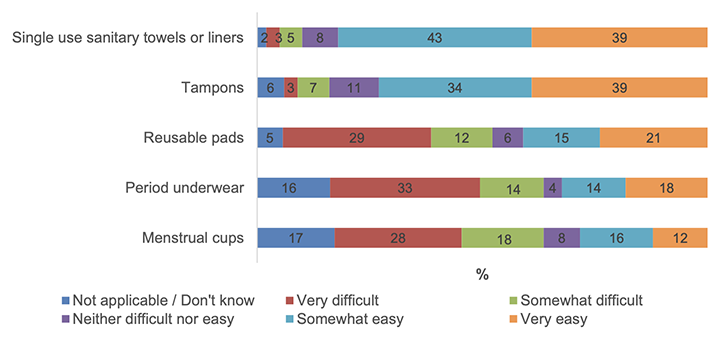
Base: All who had accessed free period products (643)
Notes: Figure 15 displays the summary difficulty and ease levels of respondents. Tables A10.1-A10.7 in the data provide a breakdown of the response options on a five-point difficult/easy scale. Where stacked bars do not total 100% it is due to percentages being rounded to the nearest whole.
By sub-group, reusable products were reported to be more easily obtainable by young people compared to adults (Table 10). For example, 76% of young people reported being able to easily access reusable pads, compared to 29% of adults.
| Percentage of respondents | 12–15-year-old respondents | 16+ respondents | |
|---|---|---|---|
| Reusable pads | 36% | 76% | 29% |
| Period underwear | 32% | 72% | 26% |
| Menstrual cups | 28% | 64% | 23% |
Base: All who had accessed free period products (643); young people (12-15 years) who had accessed free period products (86); adults 16+ who had accessed free period products (557)
Question: A10.1-A10.7. Looking at the period products listed below, how easy or difficult is it to obtain them for free?
Impact of accessing free period products
Respondents who had accessed free period products were asked to consider a range of statements assessing the impact being able to obtain free period products had had on their life. The aim of the free period provision is to support equality, dignity and rights for those who menstruate and to ensure that lack of access to period products does not impact on an individual's ability to fully participate in day-to-day activities, including work and education at all levels.
Figure 16 highlights that for many respondents access to free period products had made them: more able to continue with day-to-day activities (77%), less worried about their periods (74%), and had had a positive impact on their household finances (67%).
QC10.1-C10.3. To what extent do you agree or disagree with the following statements? Being able to obtain period products for free has...
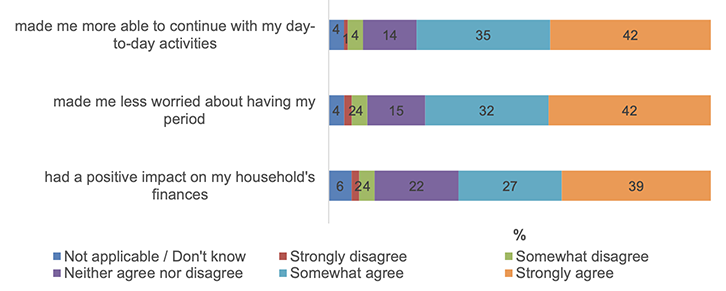
Base: All who had accessed free period products (643) apart from for the statement 'Being able to obtain period products for free has had a positive impact on my household's finances' for which the base was: All adults 16+ who had accessed free period products (557)
Notes: Figure 16 displays the summary disagreement and agreement levels of respondents. Tables C10.1-C10.3 in the data provide a breakdown of the response options on a five point agree/disagree scale. Where stacked bars do not total 100% it is due to percentages being rounded to the nearest whole.
Of those who had accessed free period products, young people were more likely than adults to agree with the statements on being less worried about their periods (87% compared to 72%) and feeling more able to continue with their day-to-day activities (92% compared to 74%).
For those who had accessed free products and responded to the statement, 'Being able to obtain period products for free has had a positive impact on my household's finances', there were some statistically significant variances by sub-groups:
- For those who struggled to afford period products, 85% agreed access to free period products had made a positive difference to their household finances (compared to 65% for those who could afford period products).
- 76% of those who were concerned about the amount of money they needed to spend on period products monthly found access to free products had a positive impact on their household's finances (compared to 58% of those with no concerns about their monthly spend on period products.
- Those with higher monthly spend on period products reported higher levels of agreement with this statement, with 80% of those spending between £11-20 and 89% of those spending over £20 agreeing with this statement (compared to 64% for those spending up to £10 per month).
Contact
Email: socialresearch@gov.scot
There is a problem
Thanks for your feedback